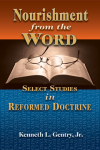 PMW 2024-025 Kenneth L. Gentry, Jr., Th.D.
PMW 2024-025 Kenneth L. Gentry, Jr., Th.D.
Creeds are important instruments for the securing and promotion of the Christian faith. The concept of creeds arise in Scripture itself. Certainly no law in Scripture explicitly commands “Thou shalt frame creeds.” Nevertheless, the impetus and mandate for creeds derives from good and necessary inferences deduced from Scripture.
We can demonstrate this in a variety of ways, three of which will suffice for our present purpose.
First, the biblical call for a public affirmation of faith serves as the prime impetus to creedalism.
The essence of Christian duty is to be a witness (Acts 1:8). This requires publicly defining the exact identity of that to which the Christian is witness. Obviously reciting the entire Scripture record at a given opportunity of witness is not possible. Furthermore, only God can look into the hearts of individuals to ascertain their innermost faith (1 Sam. 16:7; Luke 16:15). Thus, for others to know of an individual’s personal faith it is necessary to put it into words. “With the heart man believes, resulting in righteousness, and with the mouth he confesses, resulting in salvation” (Rom. 10:10). Hence, the necessity of a creed in defining the content of belief.

Nourishment from the Word
(by Ken Gentry)
Reformed studies covering baptism, creation, creeds, tongues, God’s law, apologetics, and Revelation
See more study materials at: www.KennethGentry.com
Second, mini-creeds are preserved in the biblical record of apostolic Christianity itself.
The very seeds of a full-blown creedalism are sown in the apostolic era via terse statements of faith which are widely employed. Perhaps the most familiar of these rudimentary creeds is the recurring one embedded in such texts as Acts 10:36; Romans 10:9; 1 Corinthians 12:3; and Philippians 2:11: “Jesus is Lord.” This eminently important statement embodies — “encreeds,” if you will — a particular way of viewing Jesus Christ. It is fundamentally necessary to hold as one’s credo: “I believe Jesus is Lord.”
Third, within the biblical record we find early ecclesiastical assemblies re-casting already known truths to ensure their accurate preservation and transmission.
Acts 15 is the locus classicus in this regard. There the Church restates “justification by faith” in response to a Christian-Pharisaic pressure demanding the circumcision of Gentile converts (cf. Acts 15:1).

When Shall These Things Be?
(ed. by Keith Mathison)
A Reformed response to the aberrant HyperPreterist theolgy.
Gentry’s chapter critiques HyperPreterism from an historical and creedal perspective.
See more study materials at: www.KennethGentry.com
After noting several such situations in Scripture, nineteenth-century Scottish Presbyterian theologian James Bannerman observes: “Such, within the age of inspiration itself, are the remarkable examples we have of the necessity, growing out of the circumstances of the Church and its members, that arose at different times for recasting the doctrines of Scripture in a new mold, and exhibiting or explaining it afresh under forms of language and expression more precisely fitted to meet and counteract the error of the times.”
Thus the concept of creedalism is a Scriptural one that in no way diminishes the authority of Scripture or implies its inadequacy.
The Divorce of Israel: A Redemptive-Historical Interpretation of Revelation
This long-awaited commentary is now at the printer and should be available for the public in late April, 2024. It is an 1800 page, two-volume deeply exegetical, academic commentary on the Bible’s most mysterious book.
Pre-order today for a special discount. Click: HERE


Leave a comment